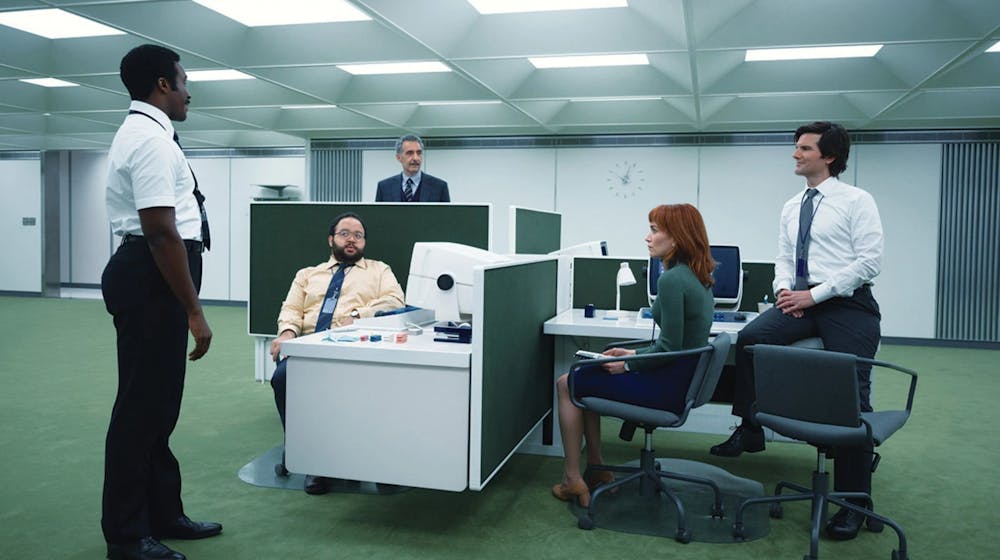“Severance” is not the first television series that explores the dark ambitions of giant corporations, but its one-of-a-kind conception of the neurosurgical procedure, “Severance,” that splits an employee’s memory into two makes it the most refreshing one in the past few years. It currently boasts a 8.7 out of 10 rating on IMDB and was renewed for a second season before the first season even ended. Although it has been on the Apple TV+ streaming platform for over five months now, personally, it has not enjoyed the recognition it deserves. With the second season projected to release early to mid-next year, now is the best time to catch up on its first season and let its spine-chilling storyline cool you down for the summer.
The story takes place in a fictional town where about half of the population works for a biotechnology company named Lumon. If this reminds you of the acclaimed series “Tales from the Loop,” be warned that the overall tones of these two series could not be more dissimilar. While “Tales from the Loop” features a somewhat mysterious town setting and ultimately offers the viewers a sense of comfort and consolation, “Severance” is disquieting and even enraging. The familiarity in its backdrop only adds to the deeply unsettling feeling that seeps into unknowing viewers. From the impersonal corporate atmosphere, to desolate suburban streets and rustic wooden cabins in the woods, almost all of the show’s audience can see a reflection of their own life in a scene or two out of “Severance.”
Mark Scout, the protagonist, is a Macrodata Refinement employee at Lumon. A former history professor, he undertook his job on a severed floor of Lumon after he lost his wife to a car accident. This meant that his work self would have no recollection of his personal experiences outside of work.
While the severance procedure in itself is fascinating and twists the idea of “work-life balance” into outright “work-life division,” viewers can soon find out that this is just the facade of the series. Lumon Industries is not as simple as it appears on the outside. The interior of the severed floor is like a maze of brightly-lit, fully white hallways, intentionally designed to separate different departments. Additionally, despite being a high-tech company, the four employees in Lumon’s department of Macrodata Refinement Department spend their entire work day picking out groups of numbers shown on a computer screen that elicit certain emotions such as fear. They have no concrete knowledge of what their work is used for.
All of these suspicious details would probably continue to be ignored by Mark if not for the coming of Helly R., the newest member of his department. Helly R. is defiant to the bizarre treatments of employees from the moment her work-self awakens from her severance procedure. Her brazen actions act as a catalyst for the change in her colleagues‘ attitude toward Lumon and their work.
Cinematography is another indispensable factor contributing to the insidious eeriness throughout the series. The filming angle frequently hovers around 30 to 45 degrees above the protagonist, and often the view is framed by an out-of-focus peripheral, both of which create a feeling of being surveilled. This violation of privacy and even autonomy for the characters in the series is enough to deliver waves of thrills to the audience, in the absence of any obviously frightening elements.
Symbolism abounds in this series. The brain, for one, is a recurring motif in the show. Lumon’s headquarter is in the shape of an ellipse in the top view. Moreover, one closer look and the viewer will realize that its composition in the top view ensembles the brain in top view. Likewise, the meandering hallways in the building interior reminds viewers of the folds and creases in the brain. On another note, the series is sprinkled with hints of religiosity surrounding Lumon. The founder of Lumon, Kier Eagan enjoys a cult of personality inside the company. Mark was told by his supervisor Ms. Cobel that his work was to “serve Kier.” There were volumes of handbooks in the company, the only books allowed in the company, that recorded the teachings and wise words of Kier. Essentially, these books are like the Bible to the employees and it is not uncommon for devoted employees to memorize and quote sentences out of these handbooks. For example, “Be content in my words, and dally not in the scholarly pursuit of lesser men.”
“Severance” handles with a multitude of profound ideas — relationship between work and life, how the continuity of memory constructs self identity, exploitation by one‘s company and by oneself. Though it progresses along more than one plotline, so far the series seems very controlled and finely executed. As for the viewers, who are simultaneously shocked and mesmerized, they will have to hold their bursting how’s and why's until the second season.
Get The Chronicle straight to your inbox
Signup for our weekly newsletter. Cancel at any time.
Katherine Zhong is a Trinity junior and local arts editor of The Chronicle's 119th volume.

